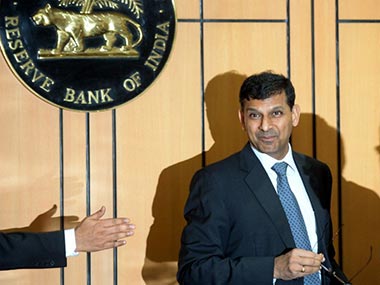The Reserve Bank of India kept its key policy interest rate unchanged at 8 percent on Tuesday but cautioned that risks to inflation remain on the upside. Retail inflation, which has become its preferred price gauge, eased to a 25-month low in February but core inflation still remains sticky at around 7.9 percent. “Retail inflation measured by the consumer price index (CPI) moderated for the third month in succession in February 2014, driven lower by the sharp disinflation in food prices, although prices of fruits, milk and products have started to firm up. Excluding food and fuel, however, retail inflation remained sticky at around 8 per cent. This suggests that some demand pressures are still at play,” the RBI said in its policy review. [caption id=“attachment_1353345” align=“alignright” width=“380”]  Raguram Rajan. AFP.[/caption] According to the RBI governor Raghuram Rajan risks to the central forecast of 8 percent CPI inflation by January 2015 stem from a less-than-normal monsoon due to possible el nino effects; uncertainty on the setting of minimum support prices for agricultural commodities and the setting of other administered prices, especially of fuel, fertiliser and electricity; the outlook for fiscal policy; geo-political developments and their impact on international commodity prices. “There will also be a downward statistical pull on CPI inflation exerted by base effects of high inflation during June-November 2013. It is critical to look through any transient effects, including these base effects, which could temporarily soften headline inflation during 2014,” the governor noted. Rajan expects headline inflation to bottom out by the third quarter of fiscal year 2015 and stressed that no further tightening will be required if inflation continues along the intended glide path. “It’s not a given that food production will plummet due to el nino. There is a lot of uncertainty and cannot anticipate what exactly will happen. If food prices do increase we have to see if it is a temporary phenomenon or a permanent one, and accordingly take a call then,” said Rajan at a press conference today. The RBI also kept the cash reserve ratio (CRR) of scheduled banks unchanged at 4 percent but increased the liquidity provided under 7-day and 14-day term repos from 0.5 percent to 0.75 percent, and decreased the liquidity provided under overnight repos under the Liquidity Adjusted Facility from 0.5 percent to 0.25 percent with immediate effect. As a Reuters report notes, with India heading for elections running from April 7 to May 12, governor Rajan may also want to wait for a glimpse of the next government’s economic policies as well as the outlook for monsoon season rains that begin in June before making a policy move. India’s consumer price index inflation slipped to 8.10 percent in February, near the RBI’s January 2015 target of 8 percent, while wholesale price index slowed to a 9-month low of 4.68 percent. However, core CPI has remained stubbornly elevated at around 8 percent. Rajan has raised the policy repo rate three times since he took over in September, including a surprise hike in January. “The only thing surprising about the monetary policy today was the lack of surprise,” said Raghuram Rajan today. The Indian equity markets continued to trade flat as a a status quo policy was priced in by the markets. While the BSE Sensex was down 10 points at 22372, Nifty was down 6 points at 6735. You can read the entire RBI policy here
The Reserve Bank of India kept its key policy interest rate unchanged at 8 percent on Tuesday but cautioned that risks to inflation remain on the upside.
Advertisement
End of Article


)

)
)
)
)
)
)
)
)



